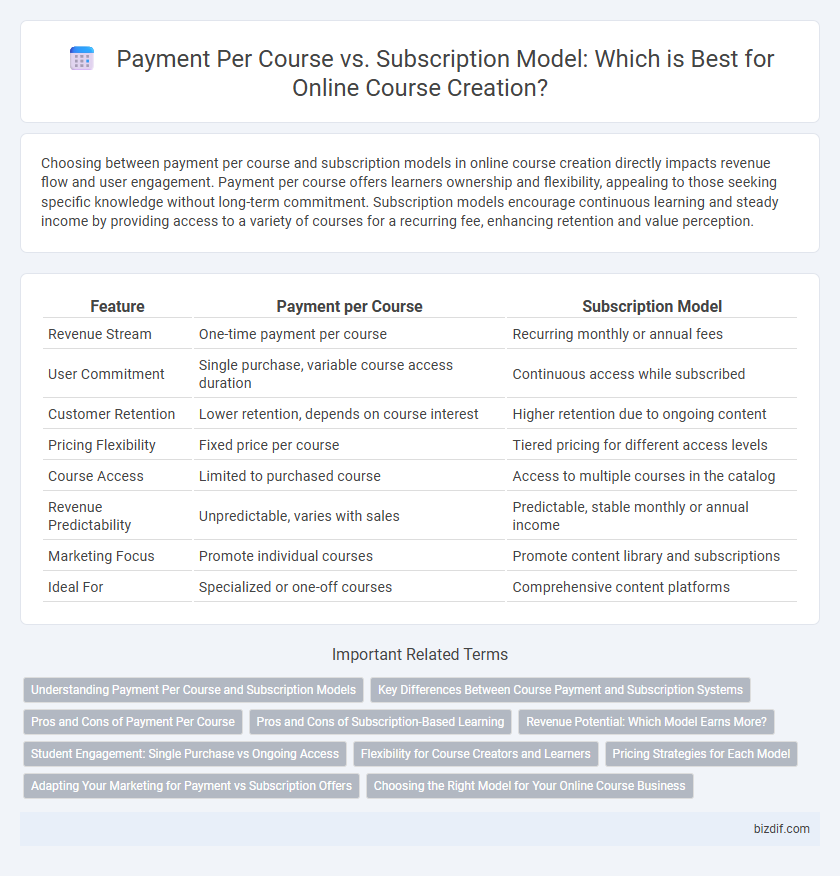Choosing between payment per course and subscription models in online course creation directly impacts revenue flow and user engagement. Payment per course offers learners ownership and flexibility, appealing to those seeking specific knowledge without long-term commitment. Subscription models encourage continuous learning and steady income by providing access to a variety of courses for a recurring fee, enhancing retention and value perception.
Table of Comparison
| Feature | Payment per Course | Subscription Model |
|---|---|---|
| Revenue Stream | One-time payment per course | Recurring monthly or annual fees |
| User Commitment | Single purchase, variable course access duration | Continuous access while subscribed |
| Customer Retention | Lower retention, depends on course interest | Higher retention due to ongoing content |
| Pricing Flexibility | Fixed price per course | Tiered pricing for different access levels |
| Course Access | Limited to purchased course | Access to multiple courses in the catalog |
| Revenue Predictability | Unpredictable, varies with sales | Predictable, stable monthly or annual income |
| Marketing Focus | Promote individual courses | Promote content library and subscriptions |
| Ideal For | Specialized or one-off courses | Comprehensive content platforms |
Understanding Payment Per Course and Subscription Models
Payment per course requires learners to make a one-time purchase for individual courses, offering clear, upfront costs and ownership of specific content. Subscription models provide unlimited access to a library of courses for a recurring fee, encouraging continuous learning and long-term engagement. Choosing between these models depends on user preferences for flexibility, budget, and access frequency.
Key Differences Between Course Payment and Subscription Systems
Course payment systems involve a one-time fee granting lifetime access to a specific online course, maximizing revenue per course and appealing to learners seeking full ownership. Subscription models charge recurring fees for ongoing access to a variety of courses, fostering continuous learning and predictable revenue streams for creators. Key differences include payment frequency, access duration, and customer retention strategies, impacting both learner commitment and cash flow stability.
Pros and Cons of Payment Per Course
Payment per course offers clear revenue for each individual sale and attracts learners unwilling to commit long-term. This model simplifies pricing structures and allows students to choose specific content tailored to their needs. However, it may limit recurring income and reduce user engagement compared to subscription models that encourage continuous learning.
Pros and Cons of Subscription-Based Learning
Subscription-based learning offers continuous access to a wide range of courses, encouraging consistent engagement and skill development over time, which can lead to higher learner retention. This model provides predictable revenue streams for course creators but may reduce immediate income per course compared to one-time payments. However, subscribers might underutilize content if motivation wanes, making it essential to regularly update material and incentivize ongoing participation.
Revenue Potential: Which Model Earns More?
Payment per course generates immediate revenue with high upfront costs from learners purchasing individual classes, attracting buyers committed to specific content. Subscription models create steady recurring income by offering unlimited access, encouraging long-term engagement and higher lifetime value per customer. Revenue potential depends on course pricing strategies, target audience behavior, and retention rates, with subscriptions often outperforming single purchases in sustained profitability.
Student Engagement: Single Purchase vs Ongoing Access
Payment per course models create a sense of commitment by requiring students to invest upfront, often leading to higher initial engagement as they aim to maximize their purchase value. Subscription models encourage ongoing access to a wider range of courses, fostering continuous learning and sustained student interaction over time. Consistent access in subscription plans typically results in increased retention rates compared to one-time purchases, which can see engagement drop once the course is completed.
Flexibility for Course Creators and Learners
Course creators benefit from payment per course by setting fixed prices, allowing direct revenue control and clear value perception, while learners gain flexibility in purchasing only desired content without long-term commitments. Subscription models provide creators with predictable recurring income and encourage ongoing engagement, giving learners unlimited access to multiple courses for a fixed fee, enhancing their learning variety and duration. Balancing these models depends on the creator's goals and learner preferences for ownership versus access flexibility.
Pricing Strategies for Each Model
Payment per course pricing allows educators to set fixed fees for individual courses, appealing to learners seeking specific skills without long-term commitments. Subscription models generate recurring revenue by granting access to multiple courses, which can enhance customer retention and increase lifetime value. Pricing strategies for subscriptions often include tiered plans and free trials to attract diverse learner segments and encourage ongoing engagement.
Adapting Your Marketing for Payment vs Subscription Offers
Tailoring your marketing strategy to highlight the benefits of payment per course versus subscription models enhances customer engagement and conversion rates. Emphasize course value and exclusivity for one-time purchases, while promoting continuous access and evolving content for subscription plans. Using targeted messaging based on user preferences and behavior data drives higher enrollment and retention for each payment structure.
Choosing the Right Model for Your Online Course Business
Selecting the appropriate payment model for your online course business significantly impacts revenue and user engagement. Payment per course suits creators with specialized, high-value content targeting niche audiences, ensuring immediate revenue per enrollment. Subscription models foster consistent cash flow and higher lifetime customer value by encouraging learners to access multiple courses over time, ideal for platforms offering diverse, continuously updated content.
Payment per course vs Subscription model Infographic

 bizdif.com
bizdif.com